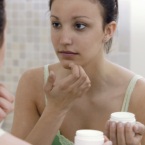Teenage Acne
 Acne is the near-universal condition that seems to say, “So you thought adolescence wasn’t already hard enough?” At its root, acne is a case of too much of a good thing. During puberty, oil glands that protect the skin from conditions like eczema go into overdrive, producing an excess of the oil, sebum, that keeps skin moist. These glands also shed dead skin cells, which can collect and block pores, causing whiteheads and blackheads (together called comedones). As these lesions become inflamed and infected, they can produce pustules, nodules, or cysts. Cysts only affect about 5% of patients, but these deep-seated lesions sometimes cause permanent scars.
Acne is the near-universal condition that seems to say, “So you thought adolescence wasn’t already hard enough?” At its root, acne is a case of too much of a good thing. During puberty, oil glands that protect the skin from conditions like eczema go into overdrive, producing an excess of the oil, sebum, that keeps skin moist. These glands also shed dead skin cells, which can collect and block pores, causing whiteheads and blackheads (together called comedones). As these lesions become inflamed and infected, they can produce pustules, nodules, or cysts. Cysts only affect about 5% of patients, but these deep-seated lesions sometimes cause permanent scars.
Treating acne
Acne seems tailor-made to frustrate teens. Just at the moment they care the most about their appearance, lesions crop up on their faces, backs, and chests. At a time of life marked by haste and urgency, treating acne requires patience, and the goal is to reduce severity of lesions rather than make them disappear completely. You’ll have to remind your teens that most of the kids they see ontelevision and in magazines have clear faces only thanks to the magic of makeup and digital correction.
Acne will tempt your teen to do things that make it worse:
- Face-washing is a good idea if done twice daily with a mild soap or a product like salicylic acid that dissolves dead skin cells. Washing more often or rubbing too hard with a washcloth, however, is likely to make things worse.
- The compulsion to squeeze acne lesions is nearly universal, but it’s also a good way to turn a mild zit into a really severe one by driving the inflammation into deeper layers of the skin.
Over-the-counter acne treatments
- The best over-the-counter acne treatments share one ingredient: benzoyl peroxide. Benzoyl peroxide comes in a variety of forms, including washes, lotions, and gels. Concentrations range from 2.25% to 10%. This is a drug that requires patience to use. Starting with too high a concentration will just inflame the skin and cause redness and peeling. Your teen should start just once a day with a wash or lotion; if the skin isn’t red or peeling, he may first increase applications to twice a day, then increase concentration, making no more than one change a week. The 10% gel is the strongest form available over-the-counter.
Prescription acne treatments
- Retinoids are another class of acne medications that can be applied to the skin, but they require a doctor’s prescription. Products, including Retin A, Differin, and other brands, come as creams or gels. Kids using retinoids are at greater risk of sunburn, so it’s important they avoid strong sun exposure and, of course, tanning salons. Just as with benzoyl peroxide, it’s a good idea to start with a low-potency form and move up slowly if needed.
- Pustules and cysts in acne usually contain a bacteria called Propionibacterium acnes, a bacteria that thrives on the excess sebum teen oil glands secrete. Antibiotics applied to the skin or taken in pill form can help control these lesions by fighting the bacteria. Some prescription acne preparations actually combine antibiotics and benzoyl peroxide.
- The strongest acne medication is also the riskiest to use. Isotretinoin, sold as Accutane, Amnesteem, Claravis, and Sotret, is a pill for severe cases of cystic acne. Isotretinoin can cause liver disease and severe birth defects, so doctors often require blood and pregnancy tests prior to prescribing it. It may also worsen depression, so close monitoring is important for patients who have a history of psychiatric problems. Because isotretinoin requires so much specialized care, it’s best prescribed by a physician who has extensive experience using it.
Skin is an organ that’s easy to take for granted, but it has a big job to do, and it’s always visible. Working with your child’s doctor, you should be able to address most skin issues with simple interventions.
Source: HealthyChildren.org